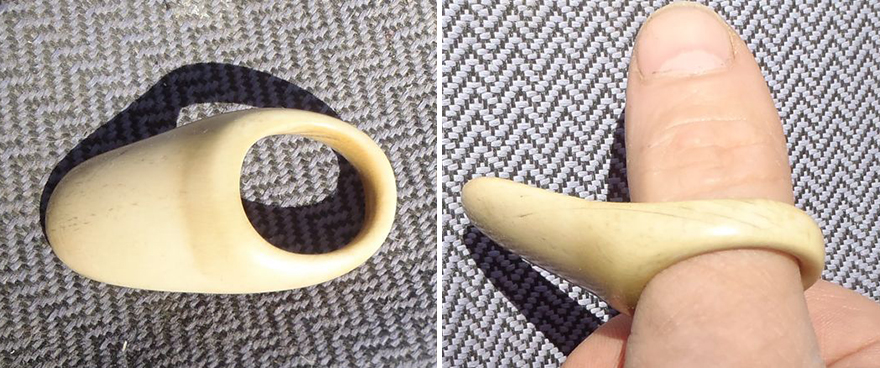A Brief History of Unusual Objects Designed to Kill People from Far Away, Part 1b: Mongolian Thumb Rings
 [Images by Fiddler49]
[Images by Fiddler49][Images by Fiddler49]
By mastering the assembly of compound materials, the Mongols had created an incredibly powerful bow, as we saw in the previous entry. But the way that they used it, which differed from the European method, necessitated a secondary support object that was the result of early ergonomic observation.

The Europeans used what is known as the "Mediterranean draw" to pull their bowstrings back. This uses the first three fingers of the hand. However, the Mongols used their thumbs to pull the string back, and curled their index and middle fingers over the thumb to support it. This, they reckoned, was stronger and allowed for a cleaner release. Whether you're an archer or not, if you use your own hand to mimic the release of either pull, you can clearly see it's easier to instantly spread your thumb, forefinger and middle finger than it is to release the first three fingers of your hand; that's because the thumb and fingers oppose, and thus balance, each other.
But concentrating over 100 pounds of force against the thumb would damage that thumb. So to protect them, the Mongols had to create yet another object: The thumb ring. This hand-carved object could be made from wood, bone, horn or antler. Here's a shot of a modern-day one owned by this Hong-Kong-based archery enthusiast:

Here's a bone model made by archery enthusiast Mike Richardson:
 [images by Mike Richardson]
[images by Mike Richardson]Richardson uses a loop tied around the string of his Western bow in conjunction with a thumb ring. As he explains,
With this system, I [can] pull 74 lbs. at a 31 inches draw and still hold it longer than most people can hold their breath (I'm 60-years-old). Now, my sons, wife and hunting buddy all shoot with a thumb ring. The draw back is that the thumb ring needs to be fitted to each user because everyone's thumb is a different size. It takes about a week to get used to this type of release.... Once you get used to the thumb draw, the advantages are hard to resist.
Even cooler, Richardson made his thumb ring himself, out of horn, and shows you how on his website:
 [images by Mike Richardson]
[images by Mike Richardson][images by Mike Richardson]
While the Mongols were practical warriors through and through that didn't favor adornment, an article on AsianArt by Eric J. Hoffman points out that succeeding empires (Chinese, Manchu, Mughal) created archer's rings with considerably more flair:
 Two Mughal jade archer's rings inlaid with gold and precious gems
Two Mughal jade archer's rings inlaid with gold and precious gemsIndia, 17th c.
(Susan Ollemans Oriental Art (left), British Museum (right))
Two Mughal jade archer's rings inlaid with gold and precious gems
India, 17th c.
(Susan Ollemans Oriental Art (left), British Museum (right))
 Magnificent Imperial set of seven archer's rings and case, Qianlong
Magnificent Imperial set of seven archer's rings and case, Qianlong(Courtesy Sotheby's Hong Kong)
Magnificent Imperial set of seven archer's rings and case, Qianlong
(Courtesy Sotheby's Hong Kong)
 Carved hardstone rings: jade (left), 3 agate rings, amber (right)
Carved hardstone rings: jade (left), 3 agate rings, amber (right)(University of Missouri Anthropology Museum)
Carved hardstone rings: jade (left), 3 agate rings, amber (right)
(University of Missouri Anthropology Museum)
 Carved jade archer's rings, one with jade case
19th-20th c.
Carved jade archer's rings, one with jade case
19th-20th c.The two green rings are jadeite, the others nephrite
(courtesy Eldred's Auction Gallery)
Carved jade archer's rings, one with jade case
19th-20th c.
The two green rings are jadeite, the others nephrite
(courtesy Eldred's Auction Gallery)
All pretty pimpish. The artisans from these latter cultures presumably had time to gussy them up as they weren't out pillaging.
-
oFavorite This
-
QComment
K
{Welcome
Create a Core77 Account
Already have an account? Sign In
By creating a Core77 account you confirm that you accept the Terms of Use
K
Reset Password
Please enter your email and we will send an email to reset your password.


